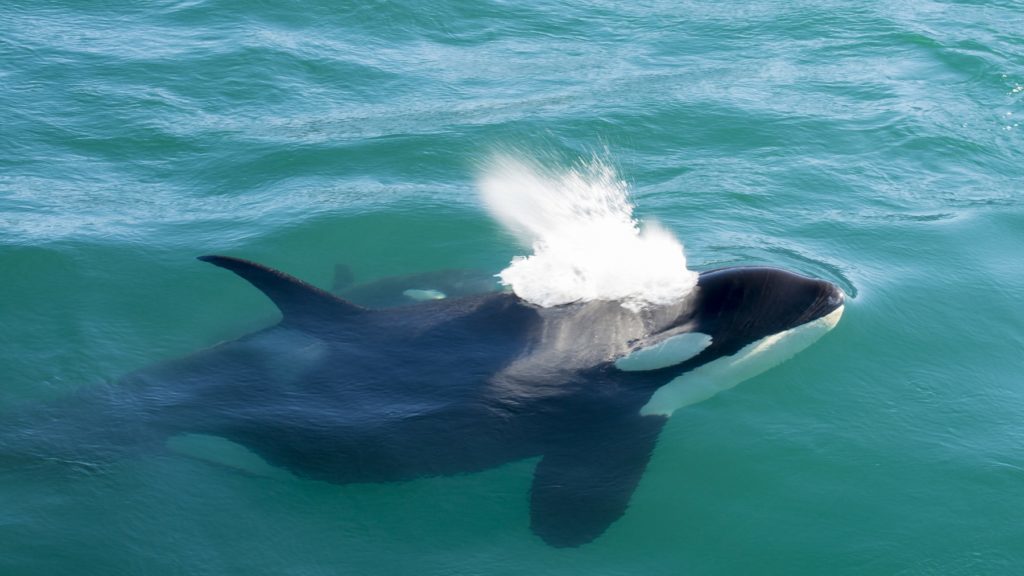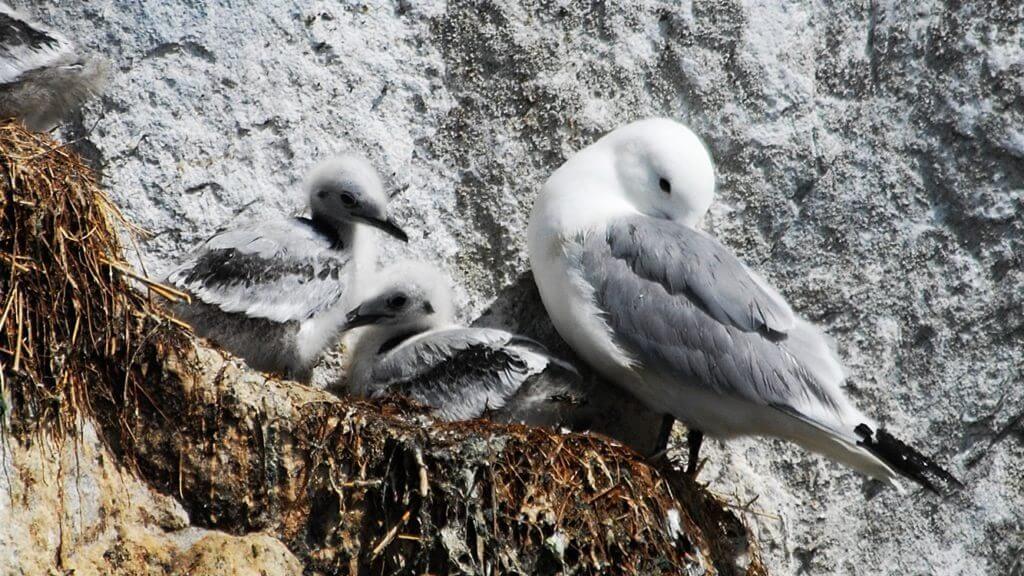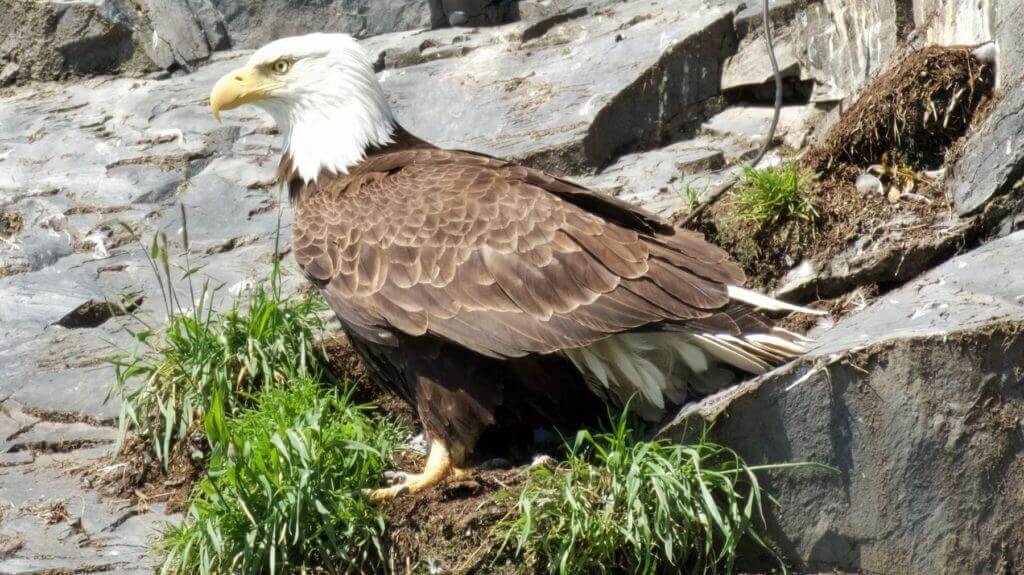Offshore Orca
It started on a May morning with a line of black fins dotted against the pearly grey backdrop of Resurrection Bay, but by the time the Orca Quest tour left the Seward Small Boat Harbor the marine radio was crackling with the news of orca fins filling every corner of Resurrection Bay. “They’re acting like offshores,” a captain ahead of us passed on, the surprise in his voice audible even through the grit of the radio channel.
I felt a surge of hope as I stepped into the wheelhouse with Captain Justin, but shoved it down because these couldn’t be offshore orca, our luck couldn’t be that good, there was no way we could have chanced to come out on the one day a year that this breed of orca frequented the waters of Resurrection Bay. Of the three types of orca, offshores are the rarest and least understood, and unlike the fish-loving residents and the marine-mammal-eating transients, offshore orca are erratic enough that they fall outside the range of most field studies. Once a year, if that, they swarm Resurrection Bay in large numbers and then disappear just as quickly, leaving a trail of shark carcasses sunken behind them. Last year, the research vessel Natoa pulled from the water the 4-foot liver of a sleeper shark which had drifted to the surface, a glimpse into the lives of offshore orca down below who would have been busy feeding on the remainder of the shark’s 11 to 12 feet in length. Even this was news; researchers first guessed that offshores fed primarily on sharks, not by observing their behavior but by pouring over skulls and hypothesizing that the roughness of shark skin might explain the worn-down stumps of these animals’ teeth.
It didn’t take long for Natoa, who happened to be on the water with a film crew from Wild Alaska Live, to confirm our hopes: these were indeed offshore orca, and they were here en masse.
I ran to the stern and watched a cluster of animals dip and rise around the blue hull of the research vessel, and it became obvious at a moment that these animals were unlike any I had ever seen. Orca have culture, passed down from family member to family member, and just as with humans each culture has its own way of using and sharing space. I couldn’t have explained it, but something about the short, erratic pulse of the way these orca tore through the water felt jagged and new, completely different from the rise of a transient’s fin that sucks silence from the water like a black hole, or the comfortable confidence of chatty residents. These animals had a completely different way of moving and of being, and I had never seen anything like it before in my life. They zig-zagged atop each other, slicing the water above and then dropping down to a meal I couldn’t know. I felt foreign, here with these animals who had seen the inside of this bay only a handful of times before, yet who had re-defined it through their own intention.
I had a job to do and it pulled me inside, but as soon as I could I ran out to the bow to look again, and I saw something that for some reason has sat with me since. I had just stepped into the slam of light and was looking wide over the grey water on our starboard side when the surface of the water bent above a mound of bubbles. I looked down just as a single orca rose up into his own breath, into the surface of his world that he had altered, and for some reason the word “wild” sat into that moment as though it were a definition. I had never seen an orca approach the surface in quite that way and that single motion spoke of creativity, of intelligence, of a reasoning I couldn’t know, or just of the desire to see his world warp. This is not my bay, I realized. This is not my water. The surface of the water was the barrier that we shared, razor-thin and full of secrets, and on this day it had bent back to teach us a little more about their foreign world.

And that is what drives us to the water: those underwater secrets, so rare as to be priceless. I don’t know if I will ever see an offshore orca again, but every trip I search for them. And though I might see them in a year or two, each day of searching brings me respect for the element of the unknown that makes these waters wild.
Kittiwake Chicks
They’re just gulls. I know that is what most passengers on the boats think at first, which is why I find it hard to explain why my binoculars are trained on a rock wall past the tumble of Steller sea lions on rocks, with the whales to my back, toward a ledge of grey and white bodies above guano-painted basalt. Black-legged kittiwakes are not rare in Resurrection Bay; alternatively, they are the most commonly-seen bird above our waters. When humpback whales feed we find them by searching for the accompanying cloud of white wings above the water. Kittiwakes are a mirror into the ocean, spooling in tandem with the schools of fish beneath the surface, present wherever life flourishes. They are an indicator species, feeding low on the food chain, an indication of the health of the ecosystem and the first to go when food grows scarce.
They also had absolutely no chicks last year.
When an indicator species fails to reproduce, alarms ring. Their loss foretells the future, as the problem behind their failure might already be making its way up the food chain. Last year, their fellow indicator species, common murres, likewise passed a season without chicks. The situation had become worrying.
Which is why, this year, I trained my binoculars on rock walls.

We saw the first chicks in late July, visible only as grey puffballs between their white parents. Soon they had graduated to gangly teenagers. Within the last few weeks these chicks have graduated to flight, their youth easily traced by the circlet of black feathers around their neck.
Kittiwakes are a business-as-usual species, so when their chicks disappear, the joy at their return becomes breathtakingly bizarre. This year, they succeeded, and so it becomes that a kittiwake fledgling becomes the most beautiful creature above our green waters.
Swimming Bob
Bald eagles. So majestic. So think most. They soar, we imagine. They crane their necks with dignified solemnity toward snow-capped peaks. They melt distance with eyes like hot coals, then drop to the water’s surface, wings spread and talons outstretched. They pose without posing. If they had an Instagram feed, the internet would simply snap.

They also, I learned this year, look ridiculous when they try to swim.
A bald eagle is large but light, and their lifting power is dependent on speed. Sometimes, though, an eagle will spy a salmon too big for even their quick-drop talons to lift. However, it just so happens that inadequacy is not a concept known to the most majestic of birds. Even if a salmon is too big for it to physically carry, the bald eagle will still drop from the sky. It will plummet towards the waiting water. It will still sink its talons into the fattest of salmon. And it will escape certain death in the most ridiculous of manners.
The eagle we watched from the Orca Song had already soared past our second deck twice, so close that Captain Kayleigh had jokingly given him a name: Bob. The third time, though it became clear that Bob was heading towards the water. Bob picked up speed. Bob crashed into the surface of the water. And Bob stayed.
Bob ruffled his feathers.
Bob began to swim.
Both wings at once, as though he were flying, our eagle scooped broad wingfuls of water backwards with each stroke. It was a butterfly stroke with no body, only wings. And Bob was fast. He pulsed through the green water, wingbeat by wingbeat, the average faster than I could have hoped to beat. Up, down, up, down, and always forward, Bob made his way towards the rubbled shore.
“Bob’s living up to his name,” I said to Katie.
She laughed. “At least we didn’t name him Sink.”
Yard by yard, Bob closed in to the shoreline. I could feel the energy in each pulse, the exhaustion of a creature of the sky carrying a fish nearly his own weight through an element he had yet to master. But he was close. The green water slipped into shadow, and then the surge heaved, and Bob sat atop a boulder, alone. Majestic once more.
And very much eating a salmon.
To End
Even within the well-loved waters of Resurrection Bay, the wildlife continues to surprise me each day. Beyond the bay the capacity for surprise triples. Never in my time with Major Marine Tours have I ever run the same trip twice. Each day on the water is completely new, and that is what keeps us continuously loving this space.
So come out on the water with us, and I can promise you nothing beyond the most beautiful scenery of your life. I can’t promise offshore orca, or swimming eagles, or a moment in time as precious as the kittiwake’s return.
I can, however, promise you all of these things in potential. At any moment, the wildlife has the power to surprise us, and that is precisely what makes it wild. We will venture out together into the great open world, armed with all of the tools for success, and then we will let the water itself give us what it will.
And we will have a trip that nobody in this world has ever had before.
Tamara Lang is a returning deckhand with Major Marine Tours in Seward. She is a writer of creative nonfiction and the author of “Upstream: A Written and Photographic Journey up the Los Angeles River.” Her writing and her travels can both can be followed on facebook at Tamara Lang Writes, or at tamaralang.com.
Signup for our newsletter to get the most recent Major Marine updates.